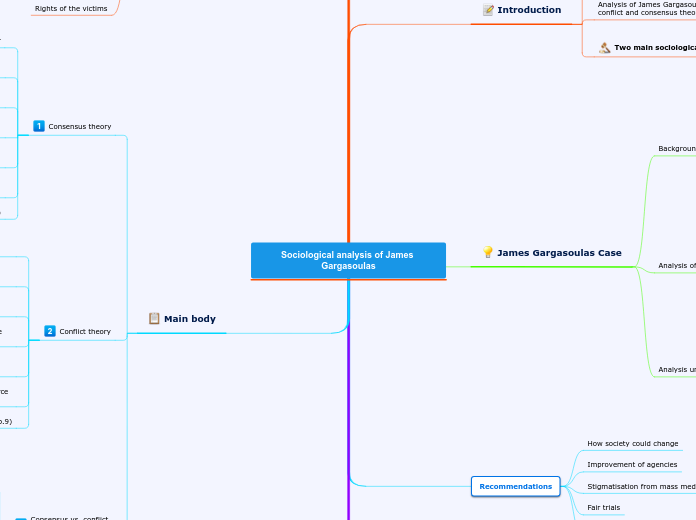Sociological analysis of James Gargasoulas
Introduction
How Sociological Theories explain human behaviour?
How they see law?
How they define crime?
How is society constructed?
Analysis of James Gargasoulas case under the conflict and consensus theory
Two main sociological perspectives
Consensus perspective
Conflict Perspective
James Gargasoulas Case
Background
Raised in a single parent family
Mother abandoned James and his brother
Abusive father
Drug issues
Mental health issues
Delusional beliefs
Analysis of the case under Consensus Theory
Deviant because of braking
social norms
Socially disapproved because
of drug use
Institutions like family and education
were almost nonexistent
Analysis under Conflict theory
He is seen as disadvantaged
Lack of opportunities
Lower social class
Brought up in rough and violent environment which led him to substance abuse and mental health issues
Recommendations
How society could change
Improvement of agencies
Stigmatisation from mass media to stop
Fair trials
Improvement of the criminal justice system
Conclusion
Brief outline of how society could change as well
as specific agencies
Sociological Issues
Police and duty of care
The role of mass media
Luck of support
Cooperation between agencies
Rights of the victims
Main body
Consensus theory
Human behaviour is seen as learned behaviour
People within society tend to follow specific patterns of behaviour
Those patterns are based on cultural rules called norms
Institutions like family, education or religion teach and spread those cultural rules/norms
People are expected to adopt approved ways of behaviour and thinking
Socialisation leads to social order and therefore to a functional society (Jones et al. 2011)
Durkheim's Functional Theory (McDonald, 2019)
Conflict theory
It sees inequalities between individuals and groups of people
Inequalities could be based on race, gender, religion, ethnicity etc.
Inequalities could also be a result of unequal distribution of wealth and power
Advantaged groups tend to dominate upon the disadvantaged
Advantaged groups have the means to manipulate laws cultural rules
Social order is achieved through the use of force (Jones et al. 2011)
Marxism (Haralambos et al. 2008, p.9)
Consensus vs. conflict
views of law and crime
Consensus Perspective
Laws are seen as a set of shared
cultural rules that apply to
everyone within the society
Breaking the social norms is
considered to be deviant and
therefore crime (Van Krieken et al. 2010)
Conflict Perspective
Law protects those who
hold wealth and power
Crime is a result of inequalities and
domination from the advantaged
groups to the disadvantaged
(Van Krieken et al. 2010)
